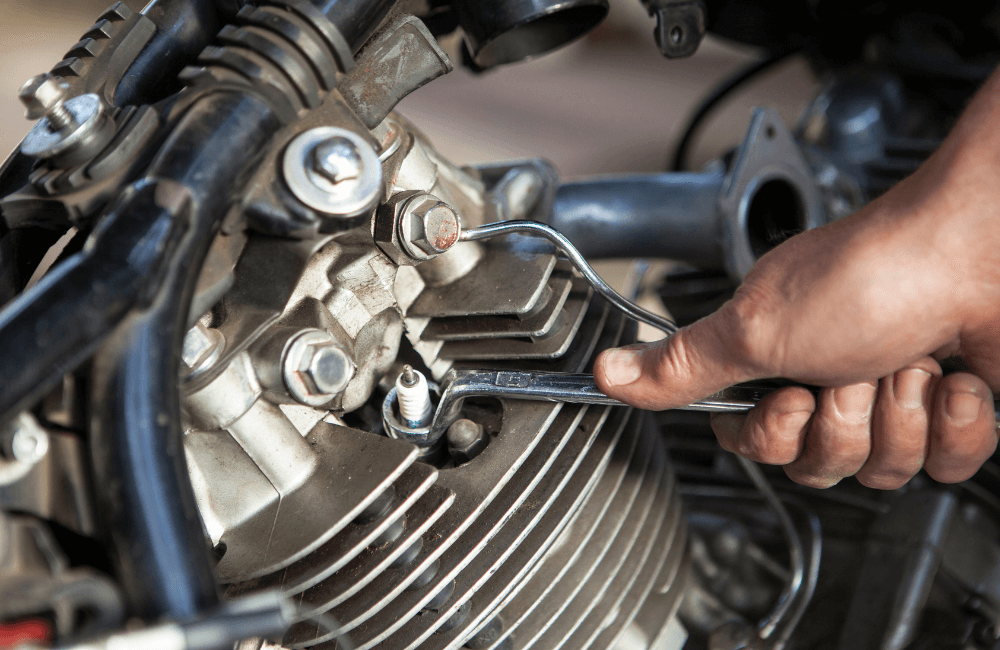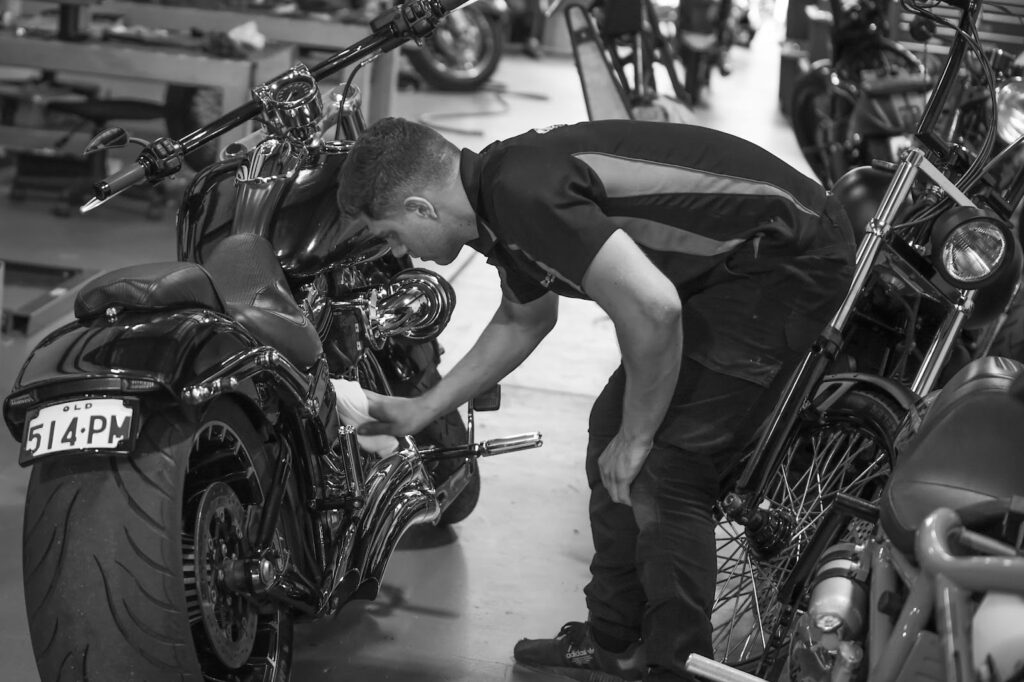Every motorcycle owner knows the engine is the beating heart. If something happens to the engine, the vehicle isn’t going anywhere. If you ever find that your engine isn’t working, or even worse—it’s flooded, it’s important to know what to do.
When it comes to a flooded motorcycle engine, there are two avenues for fixing it. You can do it by yourself—with the help of our guide, or you can visit a professional mechanic for your motorcycle repair work.
Fixing a flooded engine might seem daunting, but with our guide, we’ll run you through the steps of how to fix it, and how to prevent it from happening again in the future. The first step is determining the cause of too much gasoline in the engine.
Why Motorcycle Engines Flood

To fix a flooded motorcycle engine, it’s essential to understand how a motorcycle engine can get flooded and how it impacts the vehicle. For a motorcycle’s engine to function, it requires the right balance of air and fuel.
A flooded engine has more fuel than air, and this imbalance prevents the spark plugs from being able to ignite the fuel—stopping the engine. We’ve listed below the three most common causes of flooding, and how it impacts the engine.
- Excessive fuel can cause a flood in the engine, as it drowns out the spark.
- Overuse of the choke on a motorcycle can reduce the necessary air needed by the engine, causing flooding.
- Prolonged cranking can cause a build-up of unburnt fuel—causing a flood.
It’s important to know the signs of a flooded engine in case it ever happens. If your engine doesn’t start after several attempts, the cause could be any (or a combination) of the three above. A flooded engine can also be caused by underlying problems or damage to an engine, for example, caused by using the wrong grade of fuel.
If you suspect an engine’s flooded, check for the smell of gasoline, and if the bike’s exhaust is emitting any unburnt fuel. It could indicate a flooded engine.
How To Fix A Flooded Motorcycle Engine

Depending on the severity, fixing a flooded engine can be a quick half an hour fix, or require a trip to the mechanic.
- The first step to fixing a flooded motorcycle engine is turning off the ignition. This will also help prevent any potential further complications.
- Next, it’s important to check the spark plugs. Remove them using a spark plug wrench and turning them counterclockwise. It’s critical to be careful and not break the spark plug top.
- If the spark plugs are wet, dry it off as best you can and clean it with a cloth. Afterwards, lay it in the sun (if possible) to dry further.
- Next, drain excess fuel by opening the carburettor drain or cranking the engine with the throttle open.
- You’ll want to dry the compression cylinders. Kickstart the bike a few times to let air in.
- Once the spark plugs are completely dry, and you’ve done step 5 a few times, reinstall the spark plugs following your manufacturer’s specifications.
- Wait a few minutes for all the fuel to evaporate and more air to flow.
- With the gas still turned off and the choke off, try starting the bike again and kickstart the motor. When it starts, turn the gas back on. This should solve any minor flooded engine issue.
If your motorcycle still isn’t starting after the above steps, we recommend also checking the cylinders. It’s possible for fuel to pool in the cylinders if the engine has flooded. To check for this, you can pull out your oil plug and see if there is any gasoline in the oil. If there is, change and clean it. Riding a bike with fuel in the oil will destroy the engine.
If the engine still won’t start, there’s any visible damage, or your engine is frequently flooding, you should visit a mechanic for professional help. Repeated issues are an indicator of deeper problems with the engine.
Flooded motorcycle engine symptoms
We understand it’s not always easy to spot a flooded engine, especially during the moment. We’ve listed out the most common symptoms to look out for if you suspect a flooded engine.
- Difficulty during startup, like the engine turns over but won’t start.
- Unusual smells from the exhaust. This is particularly noticeable if the engine is flooded and unburnt fuel is coming from the exhaust.
- Sounds of the engine struggling, like irregular sputtering or popping noises.
If you spot one or any of these signs, we recommend turning off your bike and inspecting it for any problems.
Tips To Prevent A Flooded Motorcycle Engine

The best advice we can give to prevent a flooded engine is to always stay on top of your motorcycle maintenance. It’ll minimise the risk of flooding and keep your ride smooth. Below are some tips to help you prevent flooding.
Regular maintenance
A regular maintenance schedule is important not only to prevent a flooded engine but to keep your bike in top condition and the engine running efficiently. This includes:
- Check your oil level and quality regularly.
- Replace the spark plugs as recommended by the bike’s manufacturer.
- Stay on top of cleaning/changing air filters to ensure proper airflow.
- Inspect your vehicle regularly and the fuel system for any leaks or damage.
If you don’t have the time or a workshop to do motorcycle servicing, get in touch with the Taverner Motorsports team. We offer comprehensive servicing options for all makes and models.
Fuel grade
It’s essential to always ensure that you’re using the right fuel for your vehicle. If you’re unsure which grade fuel you should use check the owner’s manual. Sticking to the recommended grade of fuel is important for your bike’s engine health and preventing flooding.
Starting technique
Prolonged cranking or overuse of the choke can cause engine flooding that’s why proper starting technique is essential. The specifics will depend on the make and model of the bike, but here are the general steps:
- Turn on the ignition and wait for the fuel pump to prime.
- Hold in the clutch and press/turn on the start button.
- Release the start button immediately once the engine runs.
- If it doesn’t start, wait a few seconds before trying again.
Also, it’s important to avoid excessive revving during startup. It can cause excess fuel to enter the combustion chamber.
Professional Motorcycle Repair And Servicing At Taverner

At Taverner Motorsports, we can make a flooded motorcycle engine a thing of the past. If you need any help with motorcycle repairs and servicing, our team has the expertise to help. Our team is experienced in all aspects of motorcycle repair work, from engine repairs and electrical system troubleshooting to brake and suspension fixes; we have you covered.
We also understand the importance of using high-quality components for repairs and servicing. If you come to us for a repair or service, we have the option of both, genuine and aftermarket parts available. Taverner Motorsports will also keep you informed throughout the whole process. This includes all the repairs required, estimated costs, and a timeline for completion. You can expect transparency from start to finish.
If you require major repairs or servicing, contact us today and request a quote. Our team is more than happy to answer any questions you may have, and we work with all makes and models.
